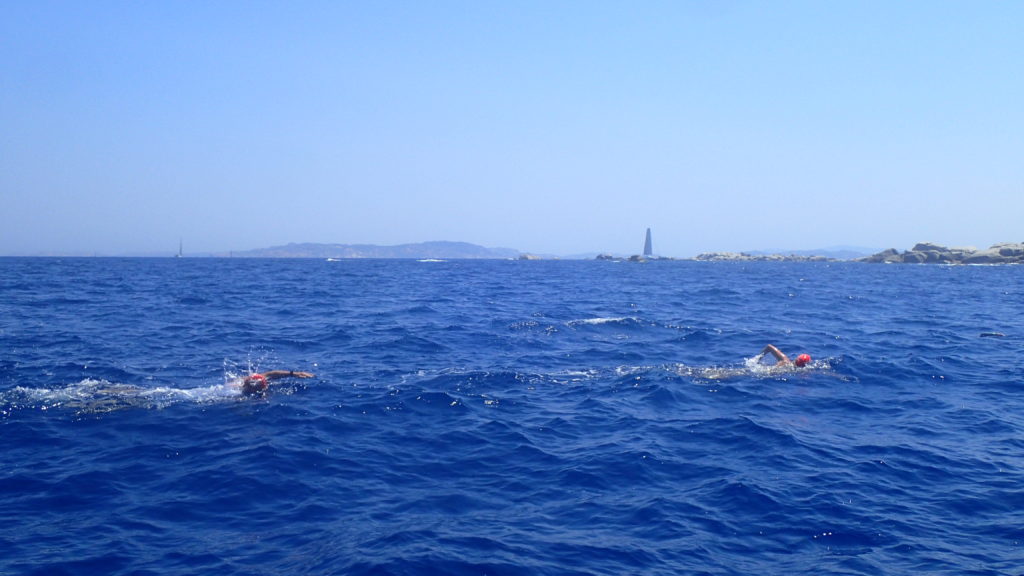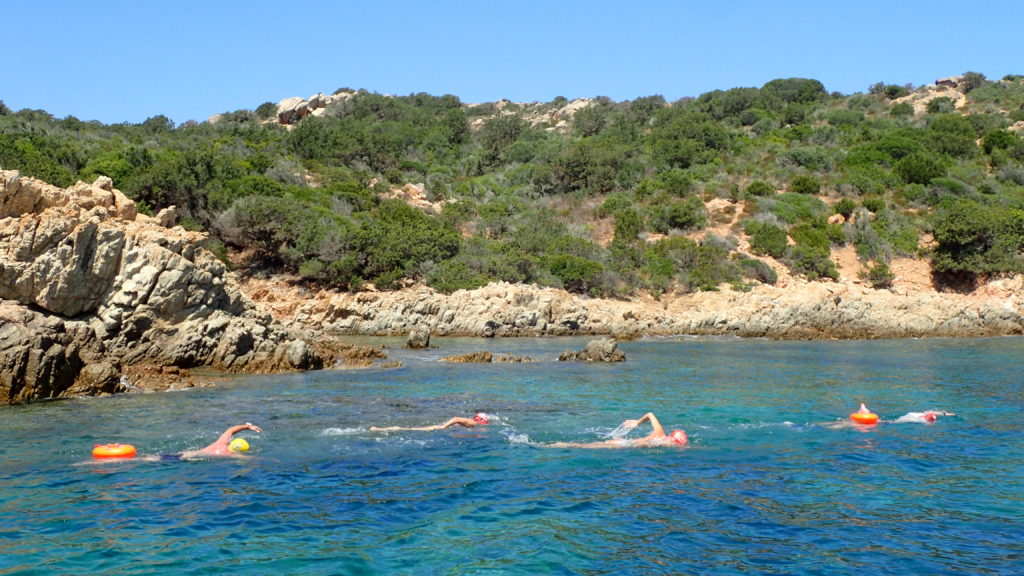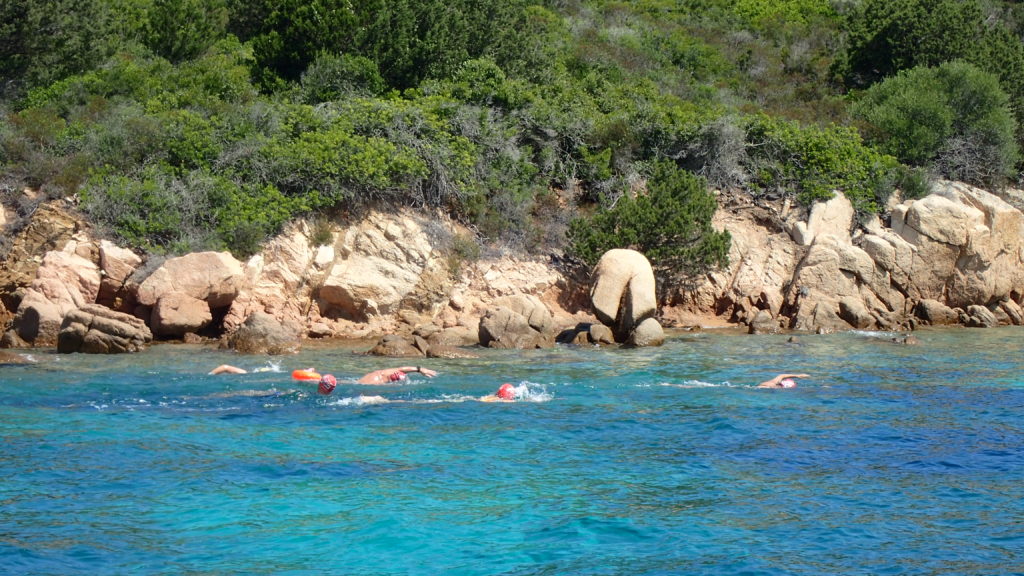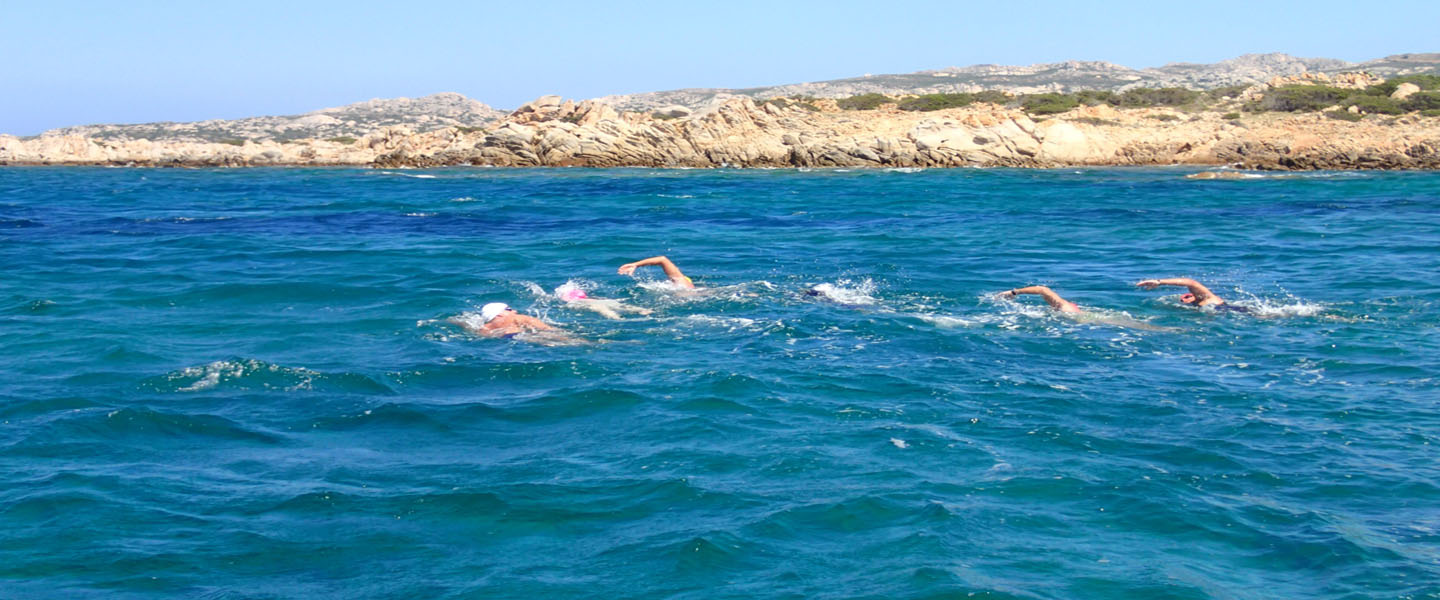SWIM & CHALLENGE – C2S
Looking for an incredible Mediterranean Sea swim crossing challenge combined with an adventure holiday full of beautiful swims within one of Europe’s most stunning archipelagos? We have the answer, make your swim challenge goals a reality by crossing the Strait of Bonifacio and also experience the vast variety of the La Maddalena archipelago coastline with its stunning rock formations and postcard sandy beaches.
Coastal swims will have a length of approximately 5 km per day. The swims will be in preparation of the main event of the expedition, the crossing from Corsica to Sardinia and exactly from Bonifacio (Capo Pertusato) to Santa Teresa di Gallura (Porto Quadro) for a total of 14 kilometres. Each day the Swimtrekking instructors will inform you of the daily itinerary and provide safety and support during the swims. Swimtrekking will provide you 6 days (5 full days and 1 half day) of coastal swims, optional coaching sessions plus crossings in La Maddalena Archipelago including the 14 km crossing from Bonifacio to Santa Teresa di Gallura.
Equipment
This is your swim challenge! What stands us alone from other crossing providers is that we aren’t rule specific in terms of swim equipment*. You are undertaking a non-competitive swim crossing; we just need to know what swim equipment you wish to use when you register. We appreciate everyone’s goals and how they wish to achieve them is different. We suggest each swimmer brings a swim costume and 2 goggles. You could also choose to bring wetsuit, fins, snorkel or any other kind of technical equipment. Swimtreeking will provide swimmers with a swim cap and t-shirt.
*The only exceptions are you must wear a swim cap provided by Swimtrekking and waterproof MP3 players are prohibited. The use of front snorkels is permissible, but the use of these is to be discussed with the lead swim instructor prior to your crossing purely for safety purposes.
About La Maddalena
The Maddalena Archipelago National Park is situated in Sardinia’s northern and comprises chain of numerous islands. The seven predominant isles are known as the “seven sisters”: Maddalena, the most important, Caprera, Santo Stefano, Spargi, Budelli, Santa Maria and Razzoli. Here, the coast is in pristine, perfect condition (unlike the inhabited centres of Maddalena); all the islands and islets are rocky in landscape, and their particularity is tied to the fact that each island is very close to the next, while the seafloor is rather shallow. These traits, along with the chromatic variations of the sea and the extraordinarily beautiful topography and terrain, create enchanting and breathtaking scenery. The Island of Maddalena is a precious gem set within this archipelago, boasting magnificent beaches lapped by waves of crystalline water, glimmering sand, and splendid seabed. Its main town centre maintains its fishing village appearance, with the municipal building, Parochial Church of Santa Maria Maddalena, in addition to locales, restaurants and shops for every type of purchase. Beyond its naturalistic attractions, the memory of Garibaldi is kept alive on Caprera via the hero’s house-museum, highly visited by tourists. The Maddalena Archipelago Park is the ideal destination for boat excursions, and scuba-diving under the emerald and turquoise, azure and cobalt blue sea. It also comprises some of the Mediterranean’s most beautiful beaches, among them the “pink beach” and Budelli Island, that owes its characteristic colour to the innumerable skeletons of tiny animals brought to its shores by the current (they are almost impossible to spot without a guide). Other standout beaches include Cala Coticciu, Brigantina and Portese on Caprera; Cala Corsara and Cala Granara on Spargi; and Cala Lunga on Razzoli. Meanwhile, the seafloor is a world unto itself, the home of countless spectacular awe-inspiring species of flora and fauna.
Dates of trip
20-26 July; 27 July-02 August
Please note: for group bookings Swimtrekking can tailor the trip to the group specific needs/requirements/dates.
About the trip
Start point: Hotel Miralonga, La Maddalena.
Start time: 20 July and 27 July @ 2 pm meet your Swimtrekking Instructors at Hotel Miralonga. Check in, packed lunch, briefing and first swim in the afternoon.
Finish point: Hotel Miralonga, La Maddalena.
Finish time: 26 July and 02 August @ 10.30 am after breakfast check out from Hotel Miralonga.
Typical day Swimtrekking
Breakfast and briefing. Pack up your essentials for the day before heading out for the morning swim. Walk to the pier in front at the hotel. Meet your boat that will take you to the swim locations. We’ll stop off in a cove for lunch, after which you have time to spend exploring. Once lunch has settled and everyone is ready to cool off in the water again, we start our second swim in a different location. At the end of the second swim the boat will take us back to the hotel.
The Crossing – General information
Location
Strait of Bonifacio,
Distance
14 kilometers according to weather conditions from Capo Pertusato (FR) to Porto Quadro (IT) or from Porto Quadro (IT) to Capo Pertusato (FR). Itinerary could also slightly change due to Italian or French coast guard decisions.
Swim Window Dates
We will have a swim crossing window of 5 days from 21 to 26 July and from 28 July to 02 August. In case of bad weather conditions, an alternative itinerary will be organized along the coastline.
The day of the crossing
Aim for a 7am start (this is subject to change at the discretion of the lead Swimtrekking instructor and boat captain). The crossing would only go ahead if the weather conditions are satisfactory and safe (neutral or favourable currents; maximum Beaufort scale (2) and only with the authorization of both the Italian and French coast guard.
Groups
All swims are non competitive. Instructor(s) will create a maximum of 3 groups. Each group will be assigned 1 support boat. Each group will have different speeds and swimmers should always swim together and as a team (pod).
Swimmers
Should wear a swim cap for all swims, Each swim group will be assigned a colour. During the week Swimtrekking instructors will take care of swim drinks and feeds, approximately every 30 minutes. Swimmers are free to prepare their personalized drinks and feeds.
See Rules and Regulations below about C2S Swim 1 week programme.
Rules and Regulations C2S Swim 1 week programme
A solid open water swimming and sea conditions knowledge base is preferential. This will help facilitate the success of crossing the Strait of Bonifacio.
Swim Equipment
This is your swim challenge! What stands us alone from other crossing providers is that we aren’t rule specific in terms of swim equipment*. You are undertaking a non-competitive swim crossing; we just need to know what swim equipment you wish to use when you register. We appreciate everyone’s goals and how they wish to achieve them is different.
*The only exceptions are you must wear a swim cap provided by Swimtrekking and waterproof MP3 players are prohibited. The use of front snorkels is permissible, but the use of these is to be discussed with the lead swim instructor prior to your crossing purely for safety purposes.
Medical Certificate
Provide a completed medical certificate from a doctor certifying that the swimmer has no medical reason which would preclude him/her from performing non-competitive swimming and is fit for the swim challenge.
Insurance (travel and life insurance)
Swimmers must have their own individual insurance which assures they are covered for any unforeseen event during their voyage. Any accident in relation to any support boats are covered by the insurance of the boat and Swimtrekking, apart from that Swimtrekking is not responsible for the consequences that arise as long as they are not within their responsibilities.
Communication and language
The swimmer, coach, mentor or support crew should be able to communicate in Italian or English.
Swimmer support crew
A maximum of one support crew is permissible for the crossing. Support crew will need to pay a discounted rate.
Aborting swim due to swimmers safety
The skipper of the main support vessel, after consultation with the doctor and lead swim support instructor has the final decision with regards to swimmers safety and aborting a swim.
Group (Pod) swimming
Instructors will split all the swimmers into 3 speed groups. Therefore every group will have swimmers with a similar swimming ability and they shall not separate more than 3 metres throughout the entirety of the crossing. If swimmers exceed this distance, the faster swimmer(s) should slow down, wait or loop back. If one or more swimmers for any reason are delayed several times, the skipper of the main support vessel, doctor and lead swim support instructor after consultation with each other have the right to remove the swimmer(s) without question. This decision will be made in the interest of the swimmer(s) safety. Depending on the health of the swimmer(s) removed from the water the swim may need to be aborted.
Feeds/Nutrition during the crossing
All feeds/nutrition is the responsibility of each swimmer. It is recommended that substances to be ingested during the crossing have been tested during your training swims and are unlikely to cause any unwanted reaction during your swim crossing. Due to varying currents in the Strait of Bonifacio and to ensure the success of the crossing it is advised that feeds are limited to a maximum of 1 minute, this will provide enough time to ingest liquids and/or solids. Swimtrekking advises feeds occur no less than 30 minutes between each stop.
Medication
All medications (non-narcotic and prescribed) that the swimmer must take during the crossing must be shown and validated by the doctor assigned by Swimtrekking prior to any boats leaving for the start of the swim.
Stimulants
The use of any performance enhancing stimulants is forbidden. This would result in your solo swim, group swim or relay not being recognised if there is evidence of such a breach.
Minimum age limit
Swimmers under 18 years of age before the year of the crossing date are not allowed.
Passports
Each swimmer and any accompanying personal must have their passport with them for the crossing day.
Start and finish of crossing
The crossing must begin after sunrise and must end before 5.30 pm.
Adverse weather conditions and/or environmental factors
The weather and environment can be unpredictable. The skipper of the main support vessel, after consultation with the lead swim support instructor may cancel the crossing before or during the swim due to adverse weather conditions and/or adverse environmental factors.
Emergency evacuation
You will hear one long blast on the whistle or fog horn. Although you may feel like you are in your natural element in the water this is not our home. If we need to remove you from the water “get out” straight away. We can discuss the reasons why we have removed you once you are on the safety of a boat. The skipper of the main support vessel or any swim support instructor all have equal final say on this.
Burocratic issues external to Swimtrekking
The swimmer understands that he/she is participating in a crossing that includes the jurisdiction of two different countries (France and Italy). Both countries have their rules, therefore any order or mandate of the authorities of those countries may affect the crossing.
Getting to La Maddalena
Ferry: from Civitavecchia, Livorno, Piombino, Genova to Olbia. The ferry companies that provide this service are; Grimaldi Lines , Moby lines , Tirrenia . Once arrived in Olbia take the public transports (bus) Arst www.arst.sardegna.it or a taxi to Palau. From Palau take the 15 minutes ride ferry to la Maddalena with Delcomar or Maddalena lines . There is also a Taxi company Sardegnatours that can take you directly to la Maddalena including the ferry ticket in the price.
Plane: you can fly to Olbia with: Easy jet , Ita Airways ,Vueling , Air Dolomiti , Lufthansa , Swiss Air , Austrian Airlines , Eurowings , Neos Air . From the airport take the public transports (bus) Arst or a taxi to Palau. From Palau take the 15 minutes ride ferry to la Maddalena with Delcomar or Maddalena lines . There is also a Taxi company Sardegnatours that can take you directly to la Maddalena including the ferry ticket in the price.
Accommodation
We stay at Hotel Miralonga for 6 nights. This will be the ideal accommodation were to start and end our expeditions around the Archipelago of La Maddalena. Miralonga has 50 comfortable and spacious rooms, equipped with color TV, private entrance, Wi-Fi and good facilities for a relaxing holiday. The Hotel located along the coastline of La Maddalena, enjoys a splendid view of the island of Santo Stefano and is about 800 meters from the main port of the island, with large car parking, swimming pool and rooms with panoramic views.
Food
Typical Italian breakfast is served in the hotel each morning from 7:30. Lunches will be a selection of sandwiches, fruit and snacks and will be served on the boat. We will have 1 dinner near the Hotel and 5 dinners in town in different restaurants. The kitchen can cater for vegetarian and gluten free diets but please ensure you inform us of your dietary requirements on booking.
Temperatures and conditions
July/August – Average air temperature is 26° Average sea temperature is 24° (degrees Celsius). Sea conditions will vary according to the weather and currents. This all adds to the experience being in open water.
What to bring
On top of your normal clothes you should bring with you: a waterproof jacket, warm sweatshirt, walking shoes/sandals, sun hat and sun glasses. There several cash points on the main island of La Maddalena so you don’t need to bring to much money along with you.
Point of interest
The Most Famous Beaches of the Mediterranean
With its 180 km of coasts, the Archipelago includes some of the most famous and charming beaches of the Mediterranean: in particular, Spiaggia Rosa (the pink beach) and Spiaggia del Cavaliere in Budelli, the beaches of Cala Coticcio and of the Relict in Caprera, Cala Corsara and Cala Granara in Spargi are worth a mention. Inlets and bays are unique landscape features: they represent several natural landing stages always offering a safe shelter to the seafarers. Inlets and bays are strictly linked to the colors of the sea for which the Archipelago is famous all over the world, in particular Porto Madonna, Cala Corsara, the Beach of Cala Lunga di Razzoli, Santa Maria, Cala Coticciu. The islands of the Archipelago are the result of geological processes that began with the Hercynian orogeny in the late Paleozoic era. A series of long moments of continuity alternating with transgressive-regressive sea level cycles during the Mesozoic and Tertiary eras, combined with tectonic uplift and subsidence phenomena involving the whole region have favored marked geomorphic processes with the formation of broad leveling surface areas both above and under the current sea level, on which inselberg and thor-shaped relief, as well as terraced surface areas remain as evidence.
The Islands
The 62 islands and islets forming the Archipelago cover a surface area of 5,134 ha, 15,046 ha in the sea. The National Park covers – including land and marine areas – 20,180 ha, with a coastal development of 180 kilometers. La Maddalena, mother island and capital of the homonymous Archipelago, is the Park gateway. It is the one and only inhabited island, except for the village of Stagnali in Caprera Island and the settlements of Santa Maria. Caprera: Garibaldi’s island. After La Maddalena, it is the second island of the Park for size, but it is the first one for the beauty of its coasts and beaches and for its particular flora. Budelli Island is considered one of the most beautiful islands of the Mediterranean, as well as symbol of Arcipelago di La Maddalena National Park, since it houses one of the most significant environmental sites of the area: Spiaggia Rosa (the pink beach). Razzoli and Santa Maria Islands are nearly united to Passo degli Asinelli. Razzoli Island lies in the northernmost section and is striking for its imposing cliffs and the shapes of its rocks, resembling Henry Moore’s sculptures. Nibani, Mortorio, Soffi and Camere are three islands situated in the south-east of the Archipelago, in front of Costa Smeralda, a few miles from Porto Cervo and Porto Rotondo, an ideal destination for yachtsmen. Spargi Island is the biggest of the four minor islands of the archipelago and is famous for its eastern beaches. Of granite origins, very rich in water and vegetation, it houses several protected bird species. Cala Corsara, Cala Connari, Cala Granara, and many other inlets surrounded by big granite rocks.
The Sea
As far as the seabed is concerned, the position of the Archipelago within Strait of Bonifacio leads to a high hydrodynamism which, associated with the scarce depth of the channels and the very low tidal range, favours the great clearness of the waters with color variations going from turquoise blue to emerald, blue, and dark blue. The seabed preserves forms of granite erosion emerged during the latest glaciation 18 ka B.P. The extremely rare concurrence of such factors has led to the formation of a marine landscape which is rather unique in the world. As far as sea biocenosis is concerned, the fishing effort of the local fishermen has never represented a risk of impoverishment for the biocenosis, even if the situation has changed in the latest decades because of the considerable increase of tourist activities, the anchoring of pleasure boats, and the unrestrained sports fishing.
La Spiaggia Rosa (The Pink Beach)
Enhanced by the extraordinary chromatic effect used by Michelangelo Antonioni in his film “Deserto Rosso”, the first colour film by the maestro from Ferrara (1964), today, thanks to the safeguard rules of the Park, it is entirely protected. The Pink Beach of Budelli is called in this way for the presence of a high percentage of bioclasts (mainly consisting of skeletal fragments of Bryozoans, especially Miriapora truncata, and foraminiferans, especially Miniacina miniacea, with a pink color) in the sedimentary formation of the sands. These bioclasts originate above all in the Posidonia oceanica meadow and feed the beach thanks to the coastal drift currents and the bottom currents. After over ten years from the introduction of the safeguard rules and the preservation measures not allowing anchorages in the Posidonia meadow, the most famous beach in the world has recovered its natural colours, the colours that bewitched the filmmaker and the many tourists attracted for years from this unique beach.
Some History
The islands of La Maddalena Archipelago are scattered throughout one of the most fascinating seas of the world. Only in the mid-17th century, a small colony of shepherds coming from the nearby Corsica took possession of the archipelago, settling in particular in the mother island of La Maddalena. Till then, the islands were deserted. The only possible human presence in the archipelago dates back to the Roman military stations and to the monastery in Santa Maria Island of the mid-13th century. Interested by the incursions of the Barbary Corsairs, the islands of the archipelago had never been inhabited before the arrival of the shepherds from Corsica. In the middle of the Mediterranean and of the maritime trade, the importance of the whole archipelago has been fully acknowledged in the works by important authors, filmmakers, and protagonists of history who have left their mark on these islands, deeply influencing the whole historical life of the community of La Maddalena.
The Granite Quarries
The quality of the granite, especially in La Maddalena in loc. Cava Francese and in Santo Stefano, has given origin to an important activity leading to a top professional production, with handicrafts exported all over the world. The most ancient quarries are interested by an environmental recovery both as fas as lichen crusts and natural vegetation development are concerned, while the most recent quarries, although abandoned, have a greater impact on the landscape which could be recovered, also considering the fact that these areas are situated in the Historical Environmental Geomining Park of Sardinia, recently recognized by UNESCO.
The Fortifications
For over two centuries, imposing sentinels of the archipelago. Authentic military architecture masterpieces, unmistakable local features. The space filled up by military structures in our territory is not the only one, although more than others it has been influenced by this presence. The central position of La Maddalena in the Mediterranean has transformed it into a military target since 1767, when the Sardinian-Piedmontese people decided to occupy it and transform it into a base for the ships of Regia Marina Sarda, which could better fight against the smugglers, against the Barbary Corsairs, and against the French in the waters of North Sardinia.
Underwater Archeology
La Maddalena has been inhabited for about 230 years. These islands, situated at the edges of Bocche di Bonifacio, have been known since ancient times, as demonstrated by archaeological and mythological evidences. Among the others, it is necessary to mention the Roman ship of Spargi, a particularly significant example of the archaeological finds coming from the submerged world of the Park, but also the precious and emblematic evidence of the passage of the most important navies of the world that have sailed these waters since ancient times.
Important information
Approximately daily swimming distance: 5 kilometers.
Crossing day: Bonifacio (Capo Pertusatu) to Santa Teresa di Gallura (Porto Quadro) 14 kilometers.
The program will be supervised by qualified Swimtrekking instructors, boat captain and doctor. All logistics will be organized via the Swimtrekking instructor. Timing and itineraries can be modified according to the sea and weather conditions and may be cancelled.
